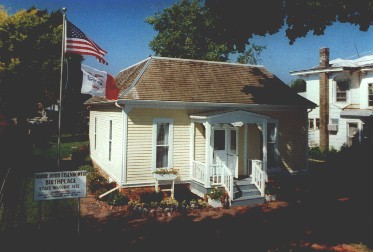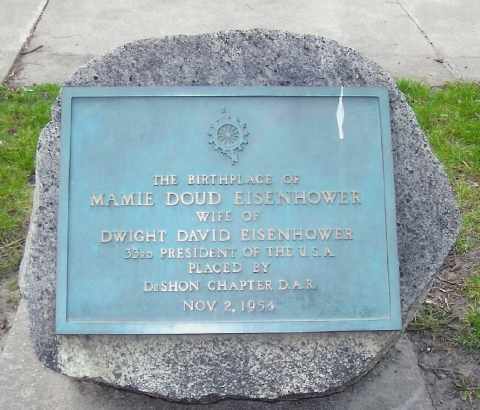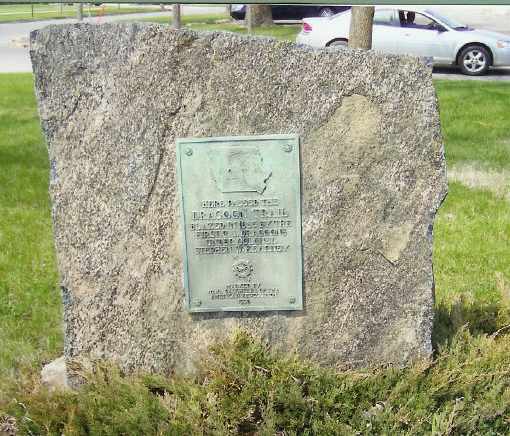|
The
city of Boone grew up when the
railroads arrived in the 1800s.
Trains are still rumbling through
Boone (about 70 a day). The
Kate Shelley High Bridge carries the
mainline of the Union Pacific
Railroad over the Des Moines River
Valley west of Boone. This bridge is
the longest and highest double-track
bridge in the world, and was
finished in 1901. The bridge is
located 3 1/2 miles northwest of
Boone. Visitors can reach the bridge
by heading north on Marion Street to
198th Road, and taking a left turn
onto the blacktop road to the
bridge. This bridge is named for
Kate Shelley, a 15-year-old
girl. During a terrible rain
storm the night of July 6, 1818,
Kate crawled across the bridge to
warn an oncoming passenger train to
stop. Thus doing, she saved many
passenger deaths.

The construction on the railroad,
operated by Boone & Scenic Valley
Railroad, was begun in 1893. Fraser
had just become the center of the
newly-discovered coal deposits and
transportation was needed to move the
coal. A line was built about 4 miles
to the west from Fraser to connect
with another railroad at Fraser
Junction, which is now called Wolf.
Railroads were expanding rapidly in
those days and they built north to
Gowrie and Rockwell City for
connections with other railroads.
The line underwent several name
changes, management, and
goals. By 1907 the railroad
reached Fort Dodge and Des Moines,
the line was electrified, and
interurban cars were operational.
At its peak, electric cars
were operated on an hourly basis. As
automobiles became numerous,
passenger service was cut back, but
the line continued to push freight
business. With the increase in
gypsum mills, sewer pipe, and drain
tile, freight business flourished,
especially in the Fort Dodge area.
The last interurban cars were
operated in September of 1955,
electric lines were removed, and
diesel engines handled the freight
business. In 1968 the Chicago &
North Western purchased the entire
line. Shortly thereafter, portions
of the line were discontinued, but
they did continue serving some grain
elevators and shippers with freight
service until 1983.
A group in Boone formed the "Boone
Railroad Historical Society."
They purchased 11.3 miles of track,
including the bridges, in order that
this scenic portion of the line
might be preserved. The first trip
handling passengers was made in
November 1983. Tickets were sold out
of a tent for rides out onto the
high bridge.
In 1984, work was begun on the
present depot, which was dedicated
in 1985. Other buildings have been
acquired, along with additional
equipment which is being restored,
as funds become available.
|
|
|
|

Mamie
Doud Eisenhower House
The town of Boone is also
known for being the birthplace of
Mamie Doud Eisenhower. The home
where she was born is located at 709
Carroll Street, Boone, Iowa. Mamie
Doud was born in Boone, Iowa, November
14, 1896, and lived there for nine
months with her parents, John and
Elivera (Carlson) Doud.  On July 1, 1916, she
married Lt. Dwight D. Eisenhower - the
same day he was promoted to First
Lieutenant in the Army. After an
illustrious Army career through World
War II, Eisenhower was elected the
34th President of the United States
and Mamie became First Lady. Mrs.
Eisenhower's restored birthplace has
an inscribed historical marker placed
in the yard by the DeShon Chapter DAR
on November 2, 1954. On July 1, 1916, she
married Lt. Dwight D. Eisenhower - the
same day he was promoted to First
Lieutenant in the Army. After an
illustrious Army career through World
War II, Eisenhower was elected the
34th President of the United States
and Mamie became First Lady. Mrs.
Eisenhower's restored birthplace has
an inscribed historical marker placed
in the yard by the DeShon Chapter DAR
on November 2, 1954.
To drive there, you
would proceed north from Highway 30
on Story Street to 8th Street, then
proceed west four blocks to Carroll
Street, and then 1/2 block
south. For more information on
the birthplace of Mamie Doud
Eisenhower, contact the museum at
515-432-1896.
|

Dragoon
Trail in Boone County
The Dragoon Trail
stretched from the Missouri line to
the northern Iowa border as the
first U.S. Dragoons under Colonel
Stephen W. Kearney followed their
assignment of exploring and mapping
the state of Iowa in the mid-1830s.
Boone was one of the Iowa towns on
the Dragoon Trail route. On June 14,
1938, the Iowa Society DAR dedicated
and placed an inscribed historical
marker on a boulder to mark the
trail.
The marker is located
on Division Street. From
Highway 30, turn north on Story
Street and continue north to Mamie
Eisenhower Avenue. Turn left
(west) and drive nine blocks to
Division Street where you will see
the marker in a grass triangle.
|

